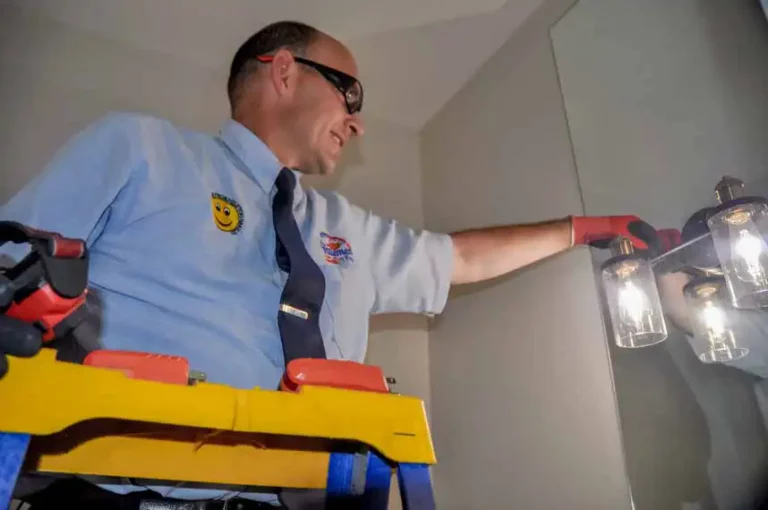Same Day Service
Since 2001

We all want to reduce risks and lower costs. And you can do that by keeping on top of your electrical repairs and with regular maintenance (we recommend every two years) of your house’s electrical system.
Regular maintenance can identify potential problems and let you fix them before they become big problems. Problems with your electricity can not only cause a lot of inconvenience, but it can also be really dangerous. Electricity is no joke, problems with or mishandling electricity can lead to serious damage, injuries, and even death. So let us take care of it for you.
Our electricians have the training, knowledge, and skills to handle electricity safely. They know all the applicable codes, regulations, and best practices and will take care of you the entire way. They will get any permits you need along with repairing your electrical problem.
We know that your and your family’s safety is paramount to you and it is for us too. So we take the utmost care to make sure your electricity is working properly and safely.
Reach out to us, we’d love to talk electricity with you. Our amazing customer care agents are waiting to take your call at (403) 879-1759 or you can fill out our handy online form.
It’s confusing and frustrating listening to your tradesperson and not understanding what they are talking about. To ease the confusion and frustration we’ve put together this list of common electrical terms and what they mean.
There are several terms so we will tackle them in more than one post.
This post deals with the definitions of basic electrical concepts and of the different electrical measurements.
An electrical current is the flow of charged particles, e.g., electrons, through a conductor.
Conductivity means a material is conductive which means the material allows electricity to flow through it.
Different materials have different levels of conductivity meaning electricity travels more easily through some materials than others. For example, copper is very conductive which is why it is used in electrical wiring. Glass and plastics have low conductivity which is why they are used in insulators.
The International System of Units (SI) unit of measurement for conductivity is siemens per meter (S/m).
If we compare electricity to water moving through a pipe, a conductive material is equivalent to a larger pipe.
A material or substance with high conductivity and low resistance is considered a conductor because it allows electricity to flow freely through it.
Most metals have good conductivity and make good conductors.
An example of an electrical conductor in residential electricity is the electrical wiring.
If you want to know what materials are the best conductors and a little more about conductivity, take a look at this.
Amperes or amps is a unit of measure and measure the rate of electron flow — also known as the electrical current — in an electrical conductor. One amp is one unit of constant electrical current.
It is similar to measuring the amount (volume) of water moving through a pipe.
The SI symbol for amperes is A.
It is the amount of electric charge running through a system OR the maximum amount of electrical current the system is designed to safely handle. It is measured in amperes.
Most houses have between a 100 amp and 200 amp service.
Volts are a unit of measure. They measure the difference in electric potential between one point and another.
They measure the “pressure” of the current. They are the speed the individual electrons travel through the circuit.
The SI symbol for volts is V.
Voltage is the size of the force moving electricity through the circuit and is expressed in volts (V).
Voltage is to electricity as water pressure is to water.
Watts are a unit of measure. It measures the rate of energy transfer to an item on the circuit over a unit of time.
One watt (W) is the rate at which work is done when one ampere (A) of current flows through an electrical potential difference of one volt (V).
The SI symbol for watts is W.
Wattage is the amount of electricity a device uses measured in watts. It’s the amount of energy transferred from the electricity to the device.
The formula to determine wattage is Watts (W) = Voltage (V) X Amperage (A)
Electrical resistance is the ability of a material to decrease the electrical current. It is the reciprocal of conductivity. Meaning if there is high resistance, there is low conductivity.
If we continue with the analogy of water moving through a pipe, resistance is a smaller pipe.
Things that impact resistance and conductivity in your house’s electrical system are:
This is because using several devices at once on a single circuit increases the resistance of the electrical wire carrying the electricity to the items.
Electrical resistance is measured in ohms.
More specifically they measure the resistance between two points in a conductor. When 1 V of electricity is applied and 1 A of current is produced, there is 1 ohm of resistance
The higher the resistance the lower the amperage(current flow).
The SI symbol for Ohms is Ω.
Ohm’s law is an equation used to determine the relationship between voltage (V), current (A), and resistance (Ω) in an electrical circuit. Essentially it is the electrical relationship between all parts of an electrical circuit.
The equation is I=VR
I = Current (A)
V = Voltage (V)
R = Resistance (Ω)
A way to visualize Ohm’s law is to compare it to water running through a pipe. The voltage is the water pressure, the amperage is the amount of water flowing through the pipe, and the resistance is the size of the pipe.
More water will flow (electrical current measured in amps) through the pipe when the pipe is larger (lower resistance measured in ohms) and the water pressure (voltage) is higher.
Electricians use Ohm’s Law all the time. One example is they use a tool plugged into a circuit that determines the circuit’s voltage and runs a simulated current through the circuit. Using this information, the electrician can use Ohm’s Law to calculate the resistance on the circuit. Remember, R=VI.
Once the electrician knows the resistance, they can determine the voltage drop. The formula for voltage drop (VD) is VD=I X R.
Voltage drop is an indicator of resistance. It is the difference in voltage at the panel and where the circuit is being tested. The greater the resistance the larger the voltage drop.
This information can tell the electrician the length of wire and quality of connections on the circuit all the way back to the panel. And if the voltage drop is high enough, it will tell them there is a problem somewhere in the circuit.



